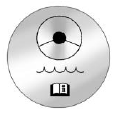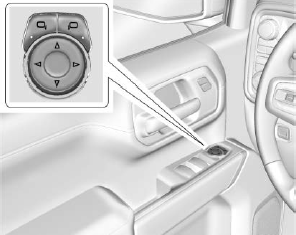Chevrolet Silverado: Vehicle Checks / Power Steering Fluid

The power steering fluid reservoir is in the engine compartment on the driver side of the vehicle. See Engine Compartment Overview for reservoir location.
When to Check Power Steering Fluid
It is not necessary to regularly check power steering fluid unless there is a leak suspected in the system or an unusual noise is heard. A fluid loss in this system could indicate a problem. Have the system inspected and repaired.
How to Check Power Steering Fluid
To check the power steering fluid:
- Set the ignition off and let the engine compartment cool down.
- Wipe the cap and the top of the reservoir clean.
- Unscrew the cap and wipe the dipstick with a clean rag.
- Replace the cap and completely tighten it.
- Remove the cap again and look at the fluid level on the dipstick.
The level should be between the ADD and FULL marks. If necessary, add only enough fluid to bring the level up to the hashed area between the ADD and FULL marks.
To prevent contamination of brake fluid, never check or fill the power steering reservoir with the brake master cylinder cover off.
What to Use
Caution
Use of the incorrect fluid may damage the vehicle and the damages may not be covered by the vehicle warranty. Always use the correct fluid listed in Recommended Fluids and Lubricants.
To determine what kind of fluid to use, see Recommended Fluids and Lubricants. Always use the proper fluid. Failure to use the proper fluid can cause leaks and damage hoses and seals.
 Engine Fan
Engine Fan
If the vehicle has the Duramax diesel engine, see the Duramax diesel supplement.
All Engines Except 6.6L V8 Engine (L8T)
The vehicle has electric cooling fan(s)...
 Washer Fluid
Washer Fluid
What to Use
When windshield washer fluid needs to be added, be sure to read the manufacturer's
instructions before use. Use a fluid that has sufficient protection against freezing
in an area where the temperature may fall below freezing...
Other information:
Chevrolet Silverado 2019-2026 Owners Manual: Fuses and Circuit Breakers
The wiring circuits in the vehicle are protected from short circuits by a combination of fuses and circuit breakers. This greatly reduces the chance of damage caused by electrical problems. Danger Fuses and circuit breakers are marked with their ampere rating...
Chevrolet Silverado 2019-2026 Owners Manual: Instrument Cluster
1500 Series Base Cluster English Shown, 2500/3500 Series and Metric Similar Midlevel Cluster English Shown, Metric Similar 1500 Series Uplevel Cluster English Standard Shown, 2500/3500 Series and Metric Similar Cluster Menu (Midlevel and Uplevel) There is an interactive display area in the center of the instrument cluster...
Categories
- Manuals Home
- 4th Generation Silverado Owners Manual
- 4th Generation Silverado Service Manual
- Electronic Stability Control (ESC) Off Light
- Power Release Tailgate
- Programming Transmitters to the Vehicle
- New on site
- Most important about car
Power Mirrors

To adjust each mirror:
Press  or
or
 to select the driver or passenger side
mirror. The indicator light will illuminate.
to select the driver or passenger side
mirror. The indicator light will illuminate.
